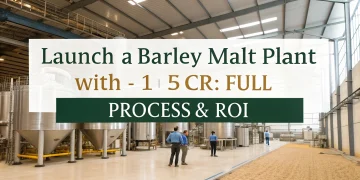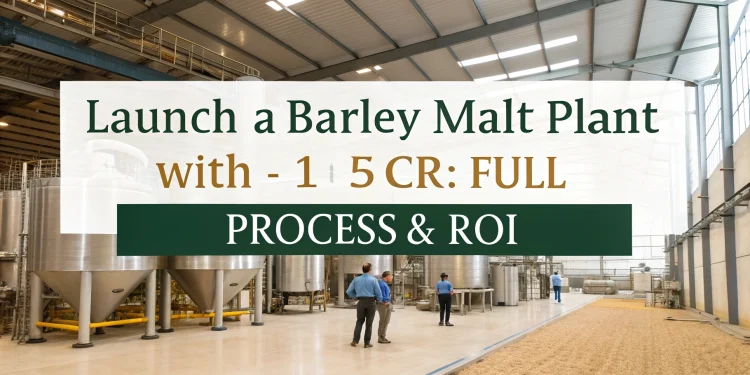Barley malt has a great significance in food and beverage industries especially in brewing, distilling, and health foods. This simple product of a cereal grain malt serves as raw materials for some of the most popular health supplements, breakfast cereals, bakery ingredients, and beverages consumed all over the world like beer and whiskey.
For businessmen, the malting industry creates an extraordinary synergy of agricultural procurement, biochemical conversion, and market flexibility.
Birch et al. (2002), highlight that with the increase in demand of natural constituents and craft brewing, knowing the complete process of transformation of barley to malt is crucial.
Malt is not simply a biologically or mechanically produced product. Malt is a biologically controlled product, or undergoing a transformation “from barley to malt”, entails biochemical processes that render dormant grains eminently useful, as they are rendered enzymatically active, flavorful, and digestible—with the potential of being used for a multitude of purposes.
In this article, we present a detailed analysis of the malting process, including the scientific concepts that underpin it, the structural and entrepreneurial considerations of the barley malt industry, as well as its economic prospects for prospective investors within and outside India.
The Role of Barley Malt in the Economy Today
Barley is certainly one of the most versatile grains grown around the world. Its nutritional and enzymatic value increases further when processed through malting. Malted barley is one of the most important raw materials in brewing industry as it contains important amount of starches that can be converted into sugars. It is also important for the taste, color, and body of beer and whiskey.
In addition to beverages, malted barley is a key component in the manufacturing of energy foods, malted milk, biscuits, confectionery items, and even some pharmaceutical products.
It can be digested easily, which, alongside its natural sweetness and high-fiber content, makes it suitable for adults and infants alike. As such, the supply of malted barley must be qualitatively improved and it is in growing demand not only from breweries, but also from health food manufacturers, artisan bakers, and export markets.
Barley malt has good potential as an ingredient owing to the malting process which serves as a strategic investment opportunity for food innovators, agri-tech companies, and processing units in the grains and cereals value chain considering the rising demand for clean-label, plant-based, and fermented foods.
Related: Barley Malt Manufacturing
Step-by-Step Malting Process: From Value-Added Ingredient to Grain
In malting barley, biological processes occur in controlled conditions which transform the barley grain. It is evident that the barley grain undergoes a series of changes with the intention of germination such as automating the activation of sprouting enzymes and the modification of starch while simultaneously halting just before plant development sprouts.
1. Selection and Cleansing of Sample Barley
The initial step involves the acquisition of previously identified barley with the intention of possessing higher brewing value such as ‘two-row’ or ‘six-row’ barley. Empirical evaluations have determined that the best barley for malting is relatively disease-free and not too low in protein while still being uniformly sized plump without any contamination.
After cleaning, there is a malting value rather than the manifest one imported which means that once the stone is free, it now has uniform barley that fulfills germination dehydrated uniformity and microbe free germination at varying stages along with a consistent barley structure.
2. Steeping: The Water Awakening
The debris is removed, barley is placed on steeping tanks where it is soaked in water. This stage rehydrates the dry grain and actuates the embryonic enzymes that need germination. Usually, steeping is done in cycles; soaking the grain in water for some hours, then draining, aerating, and thereafter re-soaking.
The barley’s moisture content is raised from roughly 12% to about 44–46%, critical for the germination process. The directed aeration at this stage guards against bacterial contamination and maintains a sufficiency of air to the growing embryo.
Aeration not only augments the biological activity, but also brisk the cereals softening the husk, activating movement in later sequences. Notably, the steep water must also be disinfected with various acids or disinfectants to eliminate any microbial contamination.
3. Germination: The Transformation Phase
With grains fully saturated in water, they are shifted into germinating chambers or beds. Real transformation occurs here. Barley will begin to sprout over a four-six day period pre- and post-controlled humidity and temperature settings (generally at 15–20°C).
During the process to germination, some crucial enzymes are turned ‘on.’ The hydrolytic enzymes alpha-amylase and beta-amylase are also activated, and so is obsolescence of the cell walls. These enzymes will subsequently hydrolyze the starchs into fermentable sugars in the course of brewing.
In order to avoid overheating and maintain uniform growth, the grains are periodically turned with mechanical turners. Everyone can tell active germination stage because sprouts (or rootlets) and grain colonies are emerging from the grains. It is critical to stop that growth at the moment just before the grain utilizes its reserve starches—at the apex of enzymatic activity.
4. Kilning: Stopping Growth and Enhancing Flavor
Kilning of the barley is the process where germinated barley is dried to stop all biological functions. It also gives characteristic malt odor, color, and taste of the end product. The green malt is moved to kilns and dried stepwise.
Warm air is first blown on the grains to remove surface moisture which can lead to damage of the fragile enzymes. If the moisture content drops to a certain level, then the temperature is raised gradually to 80–110°C depending on the sort of malt being manufactured. This period is estimated at around 24 to 36 hours.
The kilning profile is critical to determining the type of malt produced—whether it be a pale base malt, caramel malt, or roasted malt—since each serves a different purpose in brewing or food preparation. These functions, however, all require the product to possess a moisture content of approximately 3–5% for prolonged stability and increased shelf life.
Once the kilning process completes, the dried rootlets (called sprouts) can be removed using sieving or aspiration. The nutrients within these rootlets make for excellent feeds for animals.
Types of Barley Malt and Their Uses
The temperature of the kiln alongside the time the barley is placed in drastically alters the type of barley malt produced. Pale malt being by far the most used, serving as the base ingredient for lagers and ales. Crystal and caramel malts are used at higher temperatures to add toasty flavors alongside rich colors.
Stouts and darker beers gain added bitterness and darker colors from special malts such as chocolate or black malt. These are used for the production of food alongside lighter malts, integrating the latter for their sweetness and superior digestion properties. The darker variety is incorporated into cereals, biscuits, and malt-based beverages.
Malted barley extract is used in energy drinks, breakfast supplements, and even infant foods. Malted barley is also being included in new plant-based meat alternatives and fermented functional foods.
Setting Up a Barley Malt Processing Unit: Infrastructure and Business Outlook
Establishing a malting plant entails agricultural sourcing, bioprocess control, food safety infrastructure, and other requirements. A small-scale unit requires an area of about 10,000 sq. ft. in land with controlled steeping tanks, germination beds/dry kilns, cleaning, storage, and packing systems.
Overall, investment requirements are between ₹1–5 crores based on the capacity of the plant (usually 1–10 tonnes/day), level of automation, and market linkages. However, prospects in this area look bright with growing microbreweries, health food manufacturing, and export purchasing.
India produces barley largely in the state of Rajasthan, Uttar Pradesh, and Haryana making these states ideal locations for setting up malting units. With strategic procurement, many units are also integrated with local breweries or flour mills which optimize logistics, waste, and resource management.
Key operational aspects are raw barley prices, energy and water input costs. Still, the overall margins appear positive due to the region’s value-added products like malt flour, malt extracts, and specialty malts.
Market Trends and Future Potential of Barley Malt
The expansion of malt barley is predicted to occur gradually throughout the world, with Asia-Pacific growing at the highest rate because of the increasing number of craft beer breweries, health food restaurants, and the natural food market.
In India, government policies provide financial assistance to food processing units, along with startup grants under the PMFME scheme which is making the establishment of malting units more attractive. There is expected to be a large increase in the malt production due to the boom in Indian craft breweries and health-oriented FMCG companies.
At the same time, there is an increasing potential for exports to South-East Asia, Middle East, and Africa. With India having a climatic edge for barley cultivation and low production costs, it can emerge as an important player in the international market for malt.
Related: Manufacturing of Barley Malt as a Successful Business
Conclusion: From Grain to Growth—Barley Malt as a Business Opportunity
Understanding the barley to malt transformation is essential for entrepreneurs looking to tap into the food and beverage value chain. The process blends agricultural sourcing, biochemistry, and processing technology to deliver a product that serves both traditional brewers and modern health food innovators.
As consumer awareness shifts toward clean labels, functional foods, and natural beverages, barley malt is gaining renewed attention as a versatile, high-value ingredient. With increasing demand from domestic and international markets, backed by favorable production conditions and government support, the malting industry presents a golden opportunity for agribusiness entrepreneurs.
Whether you’re a farmer looking to forward-integrate, a brewery planning in-house malt production, or an FMCG player diversifying into natural ingredients, barley malt is a rewarding path—both economically and sustainably.
Get expert guidance and a complete DPR, market report, and technical layout from Niir Project Consultancy Services (NPCS) for your barley malt venture.


























